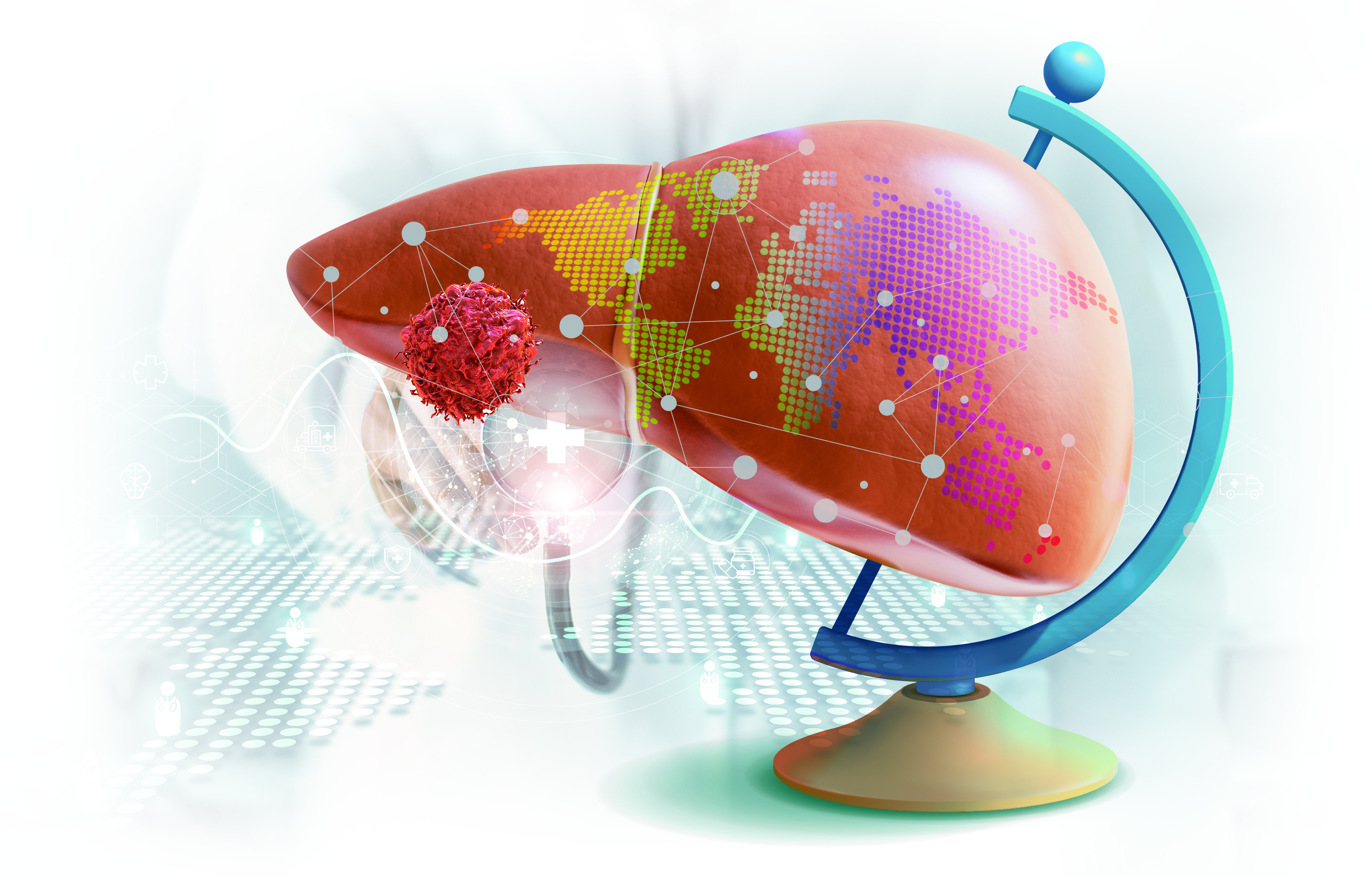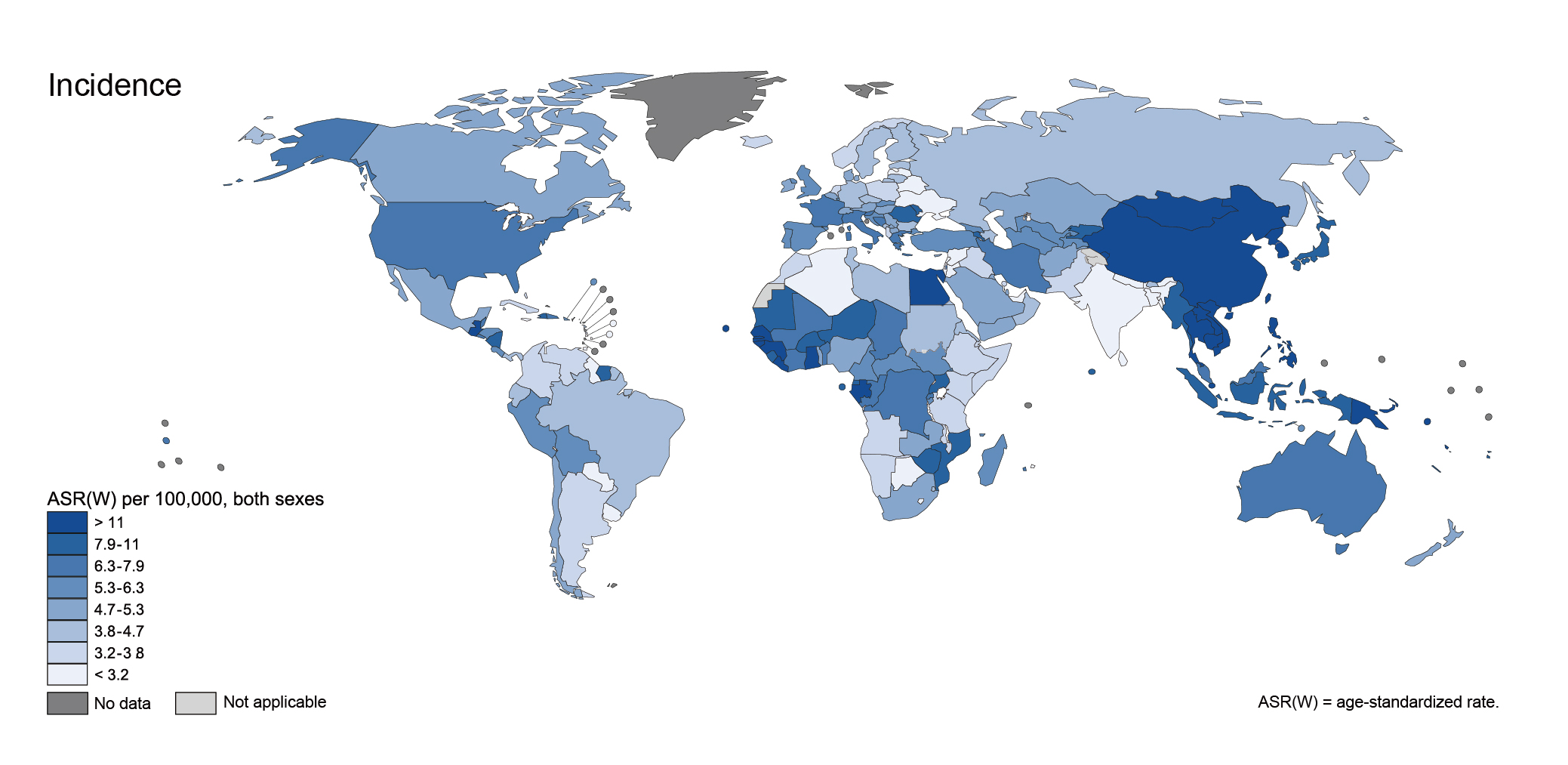
Hepatocellular carcinoma (HCC) is ranked as the sixth most common cancer worldwide and its incidence has been progressively increasing. HCC is also the third most common cause of cancer-related death, with a 5-year survival rate of just 3%1. Interestingly, HCC incidence and outcomes vary significantly across different ethnic groups. In the United States, non-White populations, including Asian Americans, Pacific Islanders, American Indians, Alaska Natives, Hispanics, and African Americans, have a higher risk of developing HCC compared to White populations . Furthermore, minority populations often face unique challenges that contribute to disparities in HCC outcomes2. Geographical differences also exist. More than half of the world’s estimated cases from liver cancer occurred in Eastern Asia (54.3%) in 2020, and China alone was home to 45.3% of the world’s liver cancer cases (Figure 1)3. In China, delayed diagnosis is common, leading to a worsened prognosis4. In view of this phenomenon, this article delves into the underlying causes of these disparities, as well as providing a brief description of treatment options and preventive measures. The mechanisms behind the ethnic and geographic differences in HCC are multifaceted, influenced by a combination of genetic, environmental, and socioeconomic factors.

Figure 1. Age-standardized liver cancer incidence rate per 100,000 people in 2020, by country3
Genetic Factors
Ethnic and geographical disparities in the incidence of HCC are associated with certain genetic factors5. Certain driver genes, such as TP53 and CDKN2A, may contribute to increased susceptibility to HCC in Asians compared to whites. Therapeutically targeting these genes might prevent HCC disparities. Also, higher expression of SATB2 may be responsible for the disparity in HCC outcomes6.
Hepatitis B Virus (HBV) Infection
HBV infection is the main cause of HCC. Worldwide, it is estimated that 44% of the HCC cases are attributed to chronic HBV infection; and the majority of such cases occur specifically in East Asia. Chronic HBV infection may be associated with a 5 to 100 fold increase in the risk of developing HCC6. In China, there are approximately 30 million people chronically infected with HBV, accounting for nearly one-third of the world's HBV infection7.
Hepatitis C Virus (HCV) Infection
An estimated 50–60% of HCC patients suffer from HCV infection in the United States; and in contrast to HBV, chronic HCV infection can cause a 15 to 20 fold increase in the risk for HCC. HCV infection is highly prevalent and causes high mortality in the African American population compared to the Caucasians or other ethnic groups6.
Aflatoxin Exposure
Aflatoxins are toxins produced predominantly by two fungi: Aspergillus flavus and Aspergillus parasiticus. Contaminated animal and plant products are the major sources of aflatoxins. There are four aflatoxins (B1, B2, G1, and G2) that have been shown to act as a carcinogen in both humans and animals. Aflatoxin B1 (AFB1) is the most potent liver carcinogen6. In China, the aflatoxin contamination rates in corn and peanuts reached as high as 70.27% and 24.24%, respectively. High aflatoxin exposure in certain areas of China may account for its high HCC prevalence7.
Lifestyle Factors
Alcohol use, either as a primary factor or in combination with HBV, HCV or diabetes, can result in the development of HCC. According to a survey, the highest rate of heavy drinking (31.6%) was observed in Hispanics compared to other ethnic minorities6. It is reported that the average alcohol consumption among the Chinese population (7.2 L of pure alcohol) was 12.5% higher than the global average (6.4 L)7. Smoking is thought to be another risk factor for HCC7. Ironically, China is the largest producer and consumer of tobacco in the world. There are more than 300 million smokers in China, nearly one-third of the world's total. More than half of adult men are current tobacco smokers. About one in every three cigarettes smoked in the world is smoked in China8.
Socioeconomic Factors
In the United States, HCC disproportionately affects disadvantaged populations, with the highest age specific rates among ethnic minorities6. Disparities in healthcare access, health literacy, and socioeconomic status may play a crucial role. Minority populations often face barriers to early detection and treatment, which can lead to poorer outcomes2. In China, the mortality rates of liver cancer vary significantly among eastern, central, and western parts of the country, consistent with the uneven economic development across different regions in China7.
Treatment Options
Treatment for HCC depends on the stage of the disease and the overall health of the patient. Surgical resection or liver transplantation can be curative for early-stage HCC. According to a recent meta-analysis, liver transplantation was associated with significantly better 5-year overall survival (OS) (64.83%) and recurrence-free survival (RFS) (70.20%) than liver resection (OS: 50.83%, odds ratio [OR]: 1.79, P < 0.001; RFS: 34.46%, OR: 5.32, P < 0.001)9. Techniques such as radiofrequency ablation (RFA) or cryoablation can be used to destroy cancer cells in localized tumors. Cryoablation has been found to be non inferior to RFA therapy for single HCC patients without lymph node invasion or distant metastasis10. Important progress has been made in the treatment of advanced HCC during the last two decades, by using targeted therapy agents which target specific pathways involved in cancer growth. Immunotherapy, including checkpoint inhibitors, has also shown promise in treating advanced HCC11. Additionally, radiation therapy can be used to control symptoms and slow the progression of the disease in advanced stages12.
Prevention Tips
The prevention of HCC involves addressing its primary risk factors. First of all, hepatitis B vaccination is a critical preventive measure, especially in regions with high HBV prevalence, such as China. Neonatal hepatitis B vaccination has proven effective in China in preventing HBV-related HCC13,14. Secondly, patients with chronic hepatitis B infection are recommended to routinely undergo screening for HCC, as HCC screening can be associated with a substantial reduction in HCC-related mortality in such patients15. Thirdly, lifestyle modification is also crucial — Reducing alcohol consumption, maintaining a healthy weight, and managing conditions like diabetes and nonalcoholic fatty liver disease can lower the risk of HCC13. Additionally, it is worthy of note that exposure to aflatoxins is associated with an increased risk of HCC. Aflatoxins are a family of toxins produced by certain fungi that are found on agricultural crops such as maize and peanuts. Therefore, minimizing exposure to aflatoxins can reduce the risk of HCC, particularly in developing countries16. Finally, addressing HCC disparities requires a patient-centered approach that incorporates infrastructure enhancements, policy changes, and improved access to care2.
Conclusion
Hepatocellular carcinoma is a complex disease with significant ethnic and geographical disparities in incidence and outcomes. Understanding the mechanisms behind these differences and implementing effective treatment and prevention strategies are crucial in reducing the global burden of HCC. Collaborative efforts among healthcare providers, researchers, and policymakers are essential to ensure equitable care for all individuals affected by this challenging disease.
References 1. KChen Z, Xie H, Hu M, et al. Recent progress in treatment of hepatocellular carcinoma. Am J Cancer Res. 2020; 10: 2993–3036. 2. Diaz A, Ruff SM, Pawlik TM. Racial, ethnic, and socioeconomic differences in hepatocellular carcinoma across the United States. Hepatoma Res. 2024; 10: 6. 3. Rumgay H, Arnold M, Ferlay J, et al. Global burden of primary liver cancer in 2020 and predictions to 2040. J Hepatol. 2022;77(6):1598–606. 4. Wei Q, Zhou H, Hou X, et al. Current status of and barriers to the treatment of advanced-stage liver cancer in China: a questionnaire-based study from the perspective of doctors. BMC Gastroenterol. 2022;22(1):351. 5. Chavda V, Zajac KK, Gunn JL, et al. Ethnic differences in hepatocellular carcinoma prevalence and therapeutic outcomes. Cancer Rep (Hoboken). 2023;6(Suppl.1): e1821. 6. Thylur RP, Roy SK, Shrivastava A, et al. Assessment of risk factors, and racial and ethnic differences in hepatocellular carcinoma. JGH Open. 2020;4(3):351–9. 7. Qin Y, Tang C, Li J, et al. Liver cancer in China: the analysis of mortality and burden of disease trends from 2008 to 2021. BMC Cancer. 2024;24(1):594. 8. WHO. Tobacco in China. Available from: https://www.who.int/china/health-topics/tobacco#:~:text=China%20is%20the%20largest%20producer,world%20is%20smoked%20in%20China. [Accessed 24 September 2024]. 9. Drefs M, Schoenberg MB, Börner N, et al. Changes of long-term survival of resection and liver transplantation in hepatocellular carcinoma throughout the years: A meta-analysis. Eur J Surg Oncol. 2024;50(3):107952. 10. Chen L, Ren Y, Sun T, et al. The efficacy of radiofrequency ablation versus cryoablation in the treatment of single hepatocellular carcinoma: A population based study. Cancer Med. 2021; 10(11): 3715–25. 11. Laface C, Fedele P, Maselli FM, et al. Targeted Therapy for Hepatocellular Carcinoma: Old and New Opportunities. Cancers (Basel). 2022; 14(16): 4028. 12. Chen CP. Role of Radiotherapy in the Treatment of Hepatocellular Carcinoma. J Clin Transl Hepatol. 2019; 7(2): 183–90. 13. Cleveland Clinic. Hepatocellular Carcinoma (HCC). 13 February 2024. Available from: https://my.clevelandclinic.org/health/diseases/21709-hepatocellular-carcinoma-hcc. [Accessed 23 September 2024]. 14. Qu C, Chen T, Fan C, et al. Efficacy of neonatal HBV vaccination on liver cancer and other liver diseases over 30-year follow-up of the Qidong hepatitis B intervention study: a cluster randomized controlled trial. PLoS Med. 2014;11: e1001774. 15. Su F, Weiss NS, Beste LA, et al. Screening is associated with a lower risk of hepatocellular carcinoma-related mortality in patients with chronic hepatitis B. J Hepatol. 2021;74(4):850– 9. 16. National Cancer Institute. Aflatoxins. 3 July 2024. Available from: https://www.cancer.gov/about-cancer/causes-prevention/risk/substances/aflatoxins. [Accessed 23 September 2024].





